Computers in Old TV Shows and Films
Humor -- by Howard Fosdick
Updated: 2024 (C) Originally published in OSNews (at OSNEWS.com)
I usually write about topics like operating systems and
computer refurbishing. Today let’s ditch that trivial stuff
and tackle something really important like… How have
computers and operating systems been portrayed in old TV shows and films?
It’s time we seek our inner geek. With this hearty sign of
approval we’re on our way to lighthearted exploration …
 (Image:NationalSpatula)
(Image:NationalSpatula)
Be Geeky and Multiply
“Sherman, Set the WABAC Machine”
Remember Mr. Peabody and his pet boy Sherman? They
co-starred in the popular TV cartoon shows Rocky
and His Friends and The Bullwinkle Show.
The former initially aired from 1959 to 1961, while the
latter ran from 1961 to 1964. (Hey, you knew it was going
downhill when they gave The Moose top billing.)
If you think you’re too young to have seen this show, think
again. Rocky and the gang have been syndicated continuously
for 60 years. (Quality does tell.) As co-star Dudley
Do-Right would say, “Have
no fear, for Rocky and friends are still here!”
For a while they ran on the Boomerang channel at 6:30 am.
Now there’s
something worth getting up for!
Or you can opt for the many successful animated
and film versions of recent years. Mr. Peabody and Sherman are
back! (yet again).
The key plot device in the show was the WABAC Machine (pronounced as the “Way Back Machine”). This is a computer that transports people back in time. Inevitably, Mr. Peabody and Sherman were transported back to a famous historical event that was going awry. They would convince important historical figures to change their actions and thus create history as we know it today.
Does it seem strange they would walk into the WABAC Machine
itself? Not to the audience of 1960. Computers filled entire
rooms back then.
The WABAC was probably named after famous 1950s computers whose names all ended in “AC” — the ENIAC, UNIVAC, and the like. I have an acquaintance who enthusiastically theorizes that the WABAC machine was actually a secret government project forked from ILLIAC at the University of Illinois. He kind of froths at the mouth when he talks about it. (Fortunately, I no longer have to work with him. He got promoted.)
Here are Mr. Peabody and Sherman entering the WABAC Machine
to correct the past. Look at those faces. Would you entrust world
history to those two goofs?
 (Image: Wikipedia)
(Image: Wikipedia)
Mr. Peabody and his pet boy Sherman enter the WABAC Machine, 1960.
“Danger, Will Robinson!”
Lost in Space was
another popular TV series that ran from 1965 until it was
cancelled in a unbelievable programming error in 1968. (What
ever happened to quality TV?) Thank goodness it came back as
a comic
book in 1991 and a film
in 1998! And like all good TV -- you just can't kill it
(even if you probably wanted to) -- it's come back yet again
in a 2018
reboot.
Computers didn’t really figure in a big way in Lost in Space. What
most viewers will remember from this fondly-cherished lost
gem is its humanoid robot. Specifically, the General Utility Non-theorizing
Environmental Control Robot, Model B9:
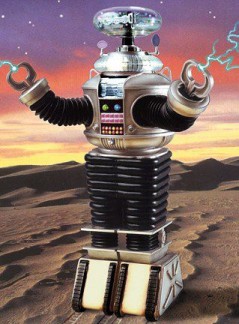
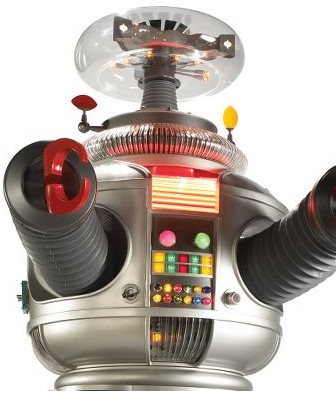
(Images: ImageyeNation
and The Lost
In Space Page)
“Danger, Will Robinson!”
It seemed like the robot was always waving its arms and saying “Danger, Will Robinson!” to warn the other characters in the show, who apparently didn’t have its manual dexterity. This happened so often that this phrase has become an expression in hacker culture and IT.
Now, here’s the unbelievable part. According to this Wikipedia article, the robot only said the complete phrase “Danger, Will Robinson!” once on the show. Specifically, in episode 11 of season 3, entitled “The Deadliest of the Species.” The robot often gave warnings of “Warning!” and “Danger!” while flailing its arms, yet it only said the classic phrase in its entirety once.
I find this really hard to believe. You know all those serious studies that compare the accuracy of Wikipedia to Encyclopedia Britannica? This just goes to show how wrong the Wiki can be! If this is indicative of the quality of online encyclopedias, I for one intend to immediately march into my parent’s attic and confiscate the EB we used as kids.
Now, about the robot. You know you want one. Admit it!
Well, you may have missed your chance. You could have bought
a full-size replica with complete animation, control and
audio features. For only $24,500
(overseas shipping extra.) What a steal! Gimme two!
Warning!, Warning! -- Sadly, I must now announce
that this item no longer is available.
While the robot regularly stole the show, there were some memorable LIS episodes where non-robotic computers figured prominently. My personal favorite was “Invaders from the 5th Dimension,” where aliens decide to capture Mr. Smith and replace their burnt-out computer with his brain. Mr. Smith, no fool he, cleverly offers them Will Robinson’s brain instead! Danger, Will Robinson!
Then there was “Cave of the Wizards,” where a computer
lures Mr. Smith into a cave so that it can take over his
mind and body and transform him into an alien. Wow, TV just
doesn’t get any better than this! (Except maybe in the
episode “Kidnapped in Space,” where a computer rules aliens
who kill John with a laser beam! (Warning!, Warning!
-- Plot Spoiler –– don’t worry, it turns out the
androids can control time and… well, you can figure it out.)
“To Boldly Go Where No Man Has Gone Before”
Dare I go where no man has gone before? I’m not a Trekkie so I could get flamed here. I mean, really melted. But the historical importance of the Star Trek franchise is simply too great to ignore. It means so much to all of us.
(Yes, my Trekkie friend who reviewed this section has already admonished me that the famous phrase was updated to “To boldly go where no one has gone before” in the TNG years.)
Star Trek is a wildly successful TV and cinema franchise. Not to mention all the spin-offs in games, books, comics, dolls, clothing, and you-name-it. On the ST page at Wikipedia (and we now know how accurate that is, don’t we?), I count 6 different Star Trek TV series and 13 films. There was even a themed attraction at Las Vegas for a decade. As John Denver would have said (several times over), “Far out!“
People devote their lives to trekking. I once encountered enthusiasts dressed in full Klingon battle gear — speaking in Klingon — while dining in Altamont, Illinois (population 2,283). Apparently they were passing through on the way to a convention in Chicago. They helpfully informed me you that can get a Klingon Dictionary for your iPhone now, as part of the Klingon Language Suite. As its ad related: “Amuse your Vulcan friends and confound your Romulan adversaries by discussing your strategy for galactic dominance in Klingon!”
What’s cool about the Trek universe is that we’re not talking about just computers or robots here. We’re actually talking operating systems! That you can actually run on your own computer!!
Let’s back trek for a minute and get all this straight. LCARS
is the operating system depicted in the Star Trek TV series and
films. It stands for the Library
Computer Access/Retrieval System. Here’s how LCARS
was depicted in the 2002 film, Star
Trek Nemesis:
 (Image: Wikipedia)
(Image: Wikipedia)
Captain Jean-Luc Picard and Lieutenant Commmanders Data
and Geordi La Forge View LCARS Output
The LCARS GUI was designed by Michael
Okuda, who went on to co-author the immortal Star
Trek TNG Technical Manual and do important design
work for the series. Unfortunately his career deteriorated
and he eventually ended up working for NASA, where he got
stuck with the prestigious NASA Exceptional Public Service
Medal. Probably pinned on him by the President himself.
Tough luck, Michael! Maybe you can still work your way back
into the franchise with the next Trek film.
For those of you who can’t wait to make LCARS your screen
background, here’s LCARS wallpaper. (Shoot me for asking,
but how is it that a 24th century computer screen has such a
1970’s color scheme?)
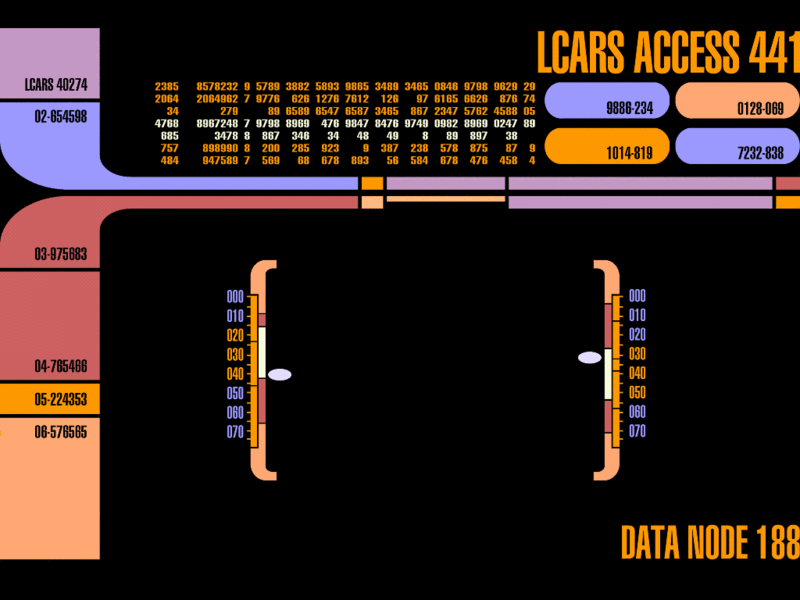 Image:
Wikipedia
Image:
Wikipedia
Enterprise-D Wallpaper …
Enjoy!
By now I imagine you just can’t stand it… you've got to to run LCARS on your computer! You have several choices. For those who want to go full retro, you can freely download LCARS24, which runs on DOS and early Windows versions. To quote the old website description, “LCARS 24 lets you turn an old TrueColor laptop into an LCARS (Starfleet-style) musical or talking alarm clock and calendar that is also an agile 32-bit DPMI system shell with many bundled LCARS programs …”
How cool is that? Your junk 1998 laptop goes Starfleet!
Here’s a sample LCARS24 screen:
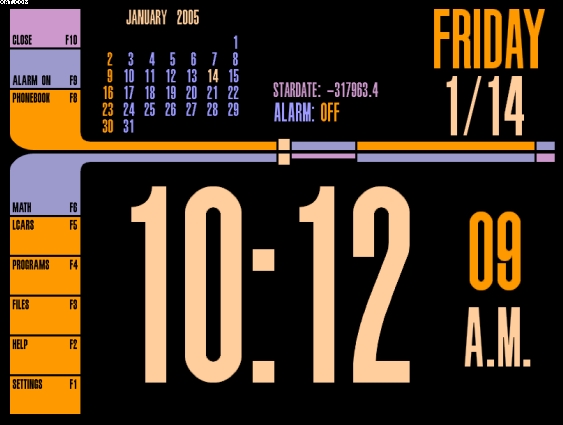 Image:Image:
Wikipedia
Image:Image:
Wikipedia
The LCARS24 Screen with Calendaring
Somebody broke the Microsoft monopoly in only three centuries?? I find that hard to believe. Make it so! (Downloads are free here.)
One other thing about Star
Trek. Ever wonder about those handheld computers
they’re always checking? They’re called PADDs, or Personal Access Display
Devices. PADDs are used by Starfleet, the Andorian
Imperial Guard, the Bajoran Militia, the Klingon Empire, the
Romulan Star Empire, the Vulcan High Command, and even in
cultures as distant as the Delta Quadrant.
Even the Cardassians use PADDs. So you can call Kim,
Kourtney, or Khloé if you’re on Mars and need a hot date.
(No disrespect intended, I actually don’t know!
which of these charming women may be married… at the
moment. And for you conspiracy theorists, have you ever
noticed how "Cardassian" and "Kardashian" are pronounced the
same? No accident, eh?)
Finally, let’s not overlook the several iPad apps
and interfaces for the LCARS experience. Turns out your
iPad was really a PADD and you just didn’t know it!
There is so much more to rave about Star Trek, but space is
limited (in this column, not in the Final Frontier in which
the Enterprise romps!). So with my deep personal regrets, we
continue on to our last film classic.
“Modernization Isn’t Everything!”
We’ve covered the heavyweights, so now let's move on to a
forgotten gem: The Computer Wore Tennis
Shoes. This laugh machine came out in 1969,
with a young teenaged Kurt
Russell in the lead role as Dexter Riley.
Dexter is a “less than average” — translation: nerdy —
college student who gets zapped while twiddling with a
mainframe computer. He absorbs the computer’s
characteristics and gains encyclopedic knowledge.
(Apparently IBM mainframes were giant repositories of facts.
I never knew that! Maybe we could replace the internet with
them.)
His newfound knowledge helps Dexter and his classmates win
college quiz competitions. But leads to friction with the
shady businessman who donated the computer to the college.
Needless to say, trouble ensues. And even a little bit of
comedy.
Catch the groovy introductory animation clip over at our National Cultural Archive (informally referred to as Youtube). It’s a real period piece.
Kurt Russell felt so good about the Dexter Riley character he went on to play him in the film sequels Now You See Him, Now You Don’t (1972) and The Strongest Man in the World (1975). The excitement all takes place at fictional Medfield College, also the location in immortal flicks like Flubber, Son of Flubber, and The Absent-Minded Professor. Did you have that much fun in college? (Should’a gone to Medfield, should’a gone to Medfield …)


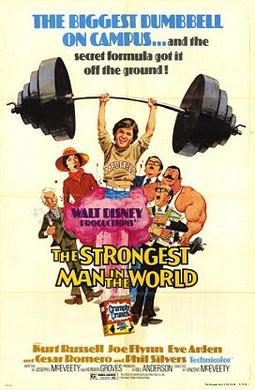 Images: IMDB
Images: IMDB
The adventures of Dexter Riley. Being a human computer was only the beginning…
A classic like this deserves a remake, and so it was, in
1995. This time 90’s teen heartthrob Kirk
Cameron became the human computer. It was only a
made-for-TV movie, but don’t worry, I hear you can still get
it on DVD. Who says America doesn’t make anything anymore?
One final observation about the original 1969 movie. Made over fifty years ago, it posits that computers are giant brains, storehouses of all knowledge, and that they're able to answer questions on any topic.
For fifty years, that proposition was outrageous. We all knew that computers weren't expert in anything at all. All they can really do is the narrow tasks they are programmed to do.
Then, in the 1990s, along came "expert systems." For the first time, computers actually could be repositories of knowledge and answer questions, though only in very narrow subject areas (their "domains").
Now, just in the past few years, "large language model" products have become available, like ChatGPT, Bard, and others. Suddenly, computers can appear to be all-knowledgable, even if they aren't. They certainly pass the turing test when it comes to human interaction.
So apparently that silly film from 1969 wasn't so far wrong after all. Within the lifetime of many of those who made that movie -- such as its star, Kurt Russell -- much of what it predicted is apparently coming true.
There's food for thought.
That’s all the excitement I can handle in one article. You
can read more about computers in old TV shows and films in my
companion article.
Or read my article about how computers are portrayed in more current films
here.
Until then, prospective Medfield students, your assignment is to list what other computers you can recall from films and TV shows.
––––––––––––––––––––––––––
Howard Fosdick is an independent consultant.
===> Like this article? Please spread the link love to Slashdot, Reddit, LXer, or wherever.